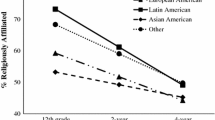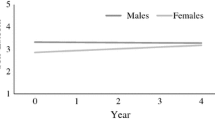Abstract
Much research has found a relationship between religion and teens’ health related behaviors. The majority of this research focuses on personal religious beliefs and behaviors. But, many religious organizations also sponsor nonreligious activities. There is reason to think that nonreligious programs sponsored by religious organizations will be more likely than school and community-based extracurricular programs to be associated with healthier behaviors, even for youth who are not personally religious. The current study compares the influence of involvement in nonreligious activities that are supported by religious and other organizations for teen health outcomes. Using two waves of longitudinal data from the National Study of Youth and Religion the current study finds that involvement in religion-supported programs is associated with feelings of well-being, better physical health, less alcohol use, and delayed initiation into first sex. Conversely, involvement in activities sponsored by nonreligious organizations is associated with more alcohol use and initiation into sex.
Similar content being viewed by others
Notes
While the majority of findings reviewed by Chitwood et al. (2008) were significant, 44 % of the reported effects of organized religious participation on alcohol use were not significant, and 47 % of the reported effects on marijuana use were not significant. Likewise, Ulmer et al. (2012) found no effect of change in religious involvement on marijuana use among adolescents.
The National Study of Youth and Religion, http://www.youthandreligion.org, was generously funded by Lilly Endowment Inc., under the direction of Christian Smith, of the Department of Sociology at the University of Notre Dame and Lisa Pearce, of the Department of Sociology at the University of North Carolina at Chapel Hill.
For cigarette and pot use the same question categories were not used during W1 and W2 surveys, and as a result, it was not possible to examine W2 smoking frequency while controlling for W1 smoking frequency.
By the second wave of NSYR, 65 % of teens reported drinking alcohol at least once outside of a religious setting. By contrast, only 29 % of teens in the sample reported having smoked a cigarette, and only 25 % consistently reported having used marijuana at all.
NSYR surveyors were instructed to exclude from the lists of activities work for pay and “just hanging out.” If the type of organized activity that the respondent reported was not obvious, NSYR surveyors were instructed to probe so that they could ascertain whether the activity was a “regular, organized activity” and not work for pay or “just hanging out”.
By removing explicitly religious activities and then including controls from questions that explicitly ask about religious attendance and youth group participation, any effects of involvement in religion-supported activities should primarily be capturing the influence of involvement in nonreligious activities that are sponsored by a religious organization. Indeed, a breakdown of the types of religion-supported activities in which teens are involved indicates that for religion-supported activities the most time was devoted to athletics.
Missing values are imputed for ten datasets based on the relationships among variables included in the analysis, and the parameter estimates are averages of regression coefficients produced through the “micombine” command in the statistical computing program, Stata.
References
Adamczyk, Amy. 2009. Socialization and selection in the link between friends’ religiosity and the transition to sexual intercourse. Sociology of Religion 70: 5–27.
Adamczyk, Amy, and Jacob Felson. 2008. Fetal positions: Unraveling the influence of religion on premarital pregnancy resolution. Social Science Quarterly 89: 17–38.
Adamczyk, Amy, and Ian Palmer. 2008. Religion’s contextual influence on marijuana use. Journal of Drug Issues 38: 717–742.
Akers, Ronald. 1985. Deviant behavior: A social learning approach, 3rd ed. Belmont: Wadsworth.
Bartkowski, John P. 2007. Religious socialization among American youth: How faith shapes parents, children, and adolescents. In The Sage handbook of the sociology of religion, ed. James A. Beckford and N.J. Demerath, III, 511–525. Thousand Oaks: Sage.
Bartkowski, John P., and Xiaohe Xu. 2007. Religiosity and teen drug use reconsidered. American Journal of Preventive Medicine 32(6): S182–S194.
Bélanger, Mathieu, Katherine Gray-Donald, Jennifer O’Loughlin, Gilles Paradis, Jennifer Hutcheon, Katerina Maximova, and James Hanley. 2009. Participation in organised sports does not slow declines in physical activity during adolescence. The International Journal of Behavioral Nutrition and Physical Activity 6: 1–6.
Broh, B.A. 2002. Linking extracurricular programming to academic achievement: Who benefits and why? Sociology of Education 75: 69–91.
Burdette, Amy M., and Terrence D. Hill. 2009. Religious involvement and transitions into adolescent sexual activities. Sociology of Religion 70: 28–48.
Chitwood, Dale D., Michael L. Weiss, and Carl G. Leukefeld. 2008. A systemic review of recent literature on religiosity and substance use. Journal of Drug Issues 38: 653–668.
Cnaan, Ram A. 1999. Social and community work by urban American religious congregations. Brookings Review 17: 50–53.
Cnaan, Ram A., Jill Sinha, and Charlene McGrew. 2004. Congregations as social service providers. Administration in Social Work 28: 47–69.
Colchico, Kristen, Patricia Zybert, and Charles E. Basch. 2000. Effects of after-school physical activity on fitness, fatness and cognitive self-perceptions: A pilot study among urban, minority adolescent girls. American Journal of Public Health 90: 977–978.
Cotton, Sian, Kathy Zebracki, Susan Rosenthal, Joel Tsevat, and Dennis Drotar. 2006. Religion/spirituality and adolescent health outcomes: A review. Journal of Adolescent Health 38(4): 472–480.
Crosnoe, Robert. 2002. Academic and health-related trajectories in adolescence: The intersection of gender and athletics. Journal of Health Social Behavior 43: 317–336.
Csikszentmihalyi, Mihaly. 1990. Flow: The psychology of optimal experience. New York: HarperCollins.
Davies, Fiona. 2009. An investigation into the effects of sporting involvement and alcohol sponsorship on underage drinking. International Journal of Sports Marketing & Sponsorship. 11(1): 25–45.
Eccles, Jacquelynne S., and Bonnie L. Barber. 1999. Student council, volunteering, basketball, or marching band: What kind of extracurricular involvement matters? Journal of Adolescent Research 14: 10–43.
Ellison, Christopher G. 1998. Introduction to symposium: Religion, health and well-being. Journal for the Scientific Study of Religion 37: 692–694.
Ellison, Christopher G., Jason D. Boardman, David R. Williams, and James S. Jackson. 2001. Religious involvement, stress and mental health: Findings from the 1995 detroit area study. Social Forces 80: 215–249.
Ellison, Christopher G., and Linda K. George. 1994. Religious involvement, social ties, and social support in a southeastern community. Journal for the Scientific Study of Religion 33: 46–61.
Feldman, Amy F., and Jennifer L. Matjasko. 2005. The role of school-based extracurricular activities in adolescent development: A comprehensive review and future directions. Review of Educational Research 75: 159–210.
Felson, Marcus. 2002. Crime and everyday life. Thousand Oaks: Pine Forge.
Franzese, Robert, and Cindy Kam. 2007. Modeling and interpreting interactive hypotheses in regression analysis. First edition: University of Michigan Press.
Fredricks, Jennifer A., and Jacquelynne S. Eccles. 2006. Is extracurricular participation associated with beneficial outcomes? Concurrent and longitudinal relations. Developmental Psychology 42(4): 698.
Good, Marie, and Teena Willoughby. 2011. Evaluating the direction of effects in the relationship between religious versus non-religious activities, academic success and substance use. Journal of Youth and Adolescence 40: 680–693.
Gruber, Jonathan, and Daniel Hungerman. 2008. The church vs. the mall: What happens when religion faces increased secular competition? Quarterly Journal of Economics 123(2): 831–862.
Hackney, Charles H., and Glenn S. Sanders. 2003. Religiosity and mental health: A meta-analysis of recent studies. Journal for the Scientific Study of Religion 42: 43–55.
Harrison, Patricia A., and Gopalakrishnan Narayan. 2003. Differences in behavior, psychological factors, and environmental factors associated with participation in school sports and other activities in adolescence. Journal of School Health 73: 113–119.
Hirschi, Travis. 1969. Causes of delinquency. Berkeley: University of California Press.
Jarvis, George, and Herbert Northcott. 1987. Religion and differences in morbidity and mortality. Social Science and Medicine 25(7): 813–824.
Jenkins, Jeanne E. 1996. The influence of peer affiliation and student activities on adolescent drug involvement. Adolescence 31: 297–306.
Jessor, Richard, Mark S. Turbin, and Frances M. Costa. 1998. Protective factors in adolescent health behavior. Journal of Personality and Social Psychology 75(3): 788–800.
Kelman, Herbert C. 2006. Interests, relationships, identities: Three central issues for individuals and groups in negotiating their social environment. Annual Review of Psychology 57: 1–26.
Levin, Martin L., Xu Xiaohe, and John P. Bartkowski. 2002. Seasonality of sexual debut. Journal of Marriage and Family 64(4): 871–884.
Mahoney, Joseph L., Amanda E. Schweder, and Hakan Stattin. 2002. Structured after-school activities as a moderator of depressed mood for adolescents with detached relations with their parents. Journal of Community Psychology 30: 69–86.
McCullough, Michael, and Brian Willoughby. 2009. Religion, self-regulation, and self-control: Associations, explanations, and implications. Psychological Bulletin 135(1): 69.
Mellor, Jennifer M., and Beth A. Freeborn. 2011. Religious participation and risky health behaviors among adolescents. Health Economics 20(10): 1226–1240.
Miller, Kathleen, Donald Sabo, Michael Farrell, Grace Barnes, and Merrill Melnick. 1998. Athletic participation and sexual behavior in adolescents: The different worlds of boy and girls. Journal of Health and Social Behavior 39: 108–123.
Miller, David N., Rich Gilman, and Matthew P. Martens. 2007. Wellness promotion in the schools: Enhancing students’ mental and physical health. Psychology in Schools 45: 1–15.
Nooney, Jennifer, and Eric Woodrum. 2002. Religious coping and church-based social support as predictors of mental health outcomes: Testing a conceptual model. Journal for the Scientific Study of Religion 41: 359–368.
Nooney, Jennifer G. 2005. Religion, stress, and mental health in adolescence: Findings from add health. Review of Religious Research 46: 341–354.
Perry-Burney, Gwendolyn D., and Baffour Kwaku Takyi. 2002. Self-esteem, academic achievement and moral development among adolescent girls. Journal of Human Behavior in the Social Environment 5: 15–27.
Pipes, Paula F., and Helen R. Ebaugh. 2002. Faith-based coalitions, social services, and government funding. Sociology of Religion 63: 49–68.
Regnerus, Mark D. 2007. Forbidden fruit: Sex and religion in the lives of American teenagers. New York: Oxford University Press.
Rew, Lynn, and Y. Joel Wong. 2006. A systematic review of associations among religiosity/spirituality and adolescent health attitudes and behaviors. Journal of Adolescent Health 38(4): 433–442.
Rostosky, Sharon S., Mark D. Regnerus, and M.L.C. Wright. 2003. Coital debut: The role of religiosity and sex attitudes in the add health survey. Journal of Sex Research 40(4): 358–367.
Salamon, Lester. 1995. Partners in public service: Government nonprofit relations in the modern welfare state. Baltimore: John Hopkins University Press.
Smith, Christian. 2003a. Religious participation and network closure among American adolescents. Journal for the Scientific Study of Religion 42: 259–267.
Smith, Christian. 2003b. Religious participation and parental moral expectations and supervision of American youth. Review of Religious Research 44: 414–424.
Smith, Christian. 2005. Soul searching: The religious and spiritual lives of American teenagers. USA: Oxford University Press.
Sutherland, Edwin Hardin. 1960. Principles of criminology, 4th ed. Philadelphia: J.B. Lippincott.
Twombly, Eric C. 2002. Religious versus other human service organizations: Implications for public policy. Social Science Quarterly 83: 947–961.
Ulmer, Jeffery T., Scott A. Desmond, Sung Joon Jang, and Byron R. Johnson. 2012. Religious involvement and dynamics of marijuana use: Initiation, persistence, and desistence. Deviant Behavior 33(6): 448–468.
US Department of Health and Human Services. 2004. Charitable choice. http://www.hhs.gov/fbci/choice.html. Accessed 12 Aug 2010.
Van Cooley, E., C. Van Nelson, and Jay Thompson. 1995. A study to determine the effect of extracurricular participation on student alcohol and drug use in secondary schools. Journal of Alcohol and Drug Education 40: 71–87.
Wallace, John M., and Tyrone A. Forman. 1998. Religion’s role in promoting health and reducing risk among American youth. Health Education & Behavior 25: 721–741.
Zill, Nicholas, Christine Winquist Nord, and Laura Spencer. 1995. Adolescent time use, risky behavior, and outcomes: An analysis of national data. Rockville: Westat.
Acknowledgments
This study was supported with a grant from the Robert Wood Johnson Foundation.
Author information
Authors and Affiliations
Corresponding author
Rights and permissions
About this article
Cite this article
Adamczyk, A., Felson, J. The Effect of Religion-Supported Programs on Health-Related Behaviors in Adolescence. Rev Relig Res 54, 469–497 (2012). https://doi.org/10.1007/s13644-012-0079-9
Received:
Accepted:
Published:
Issue Date:
DOI: https://doi.org/10.1007/s13644-012-0079-9




